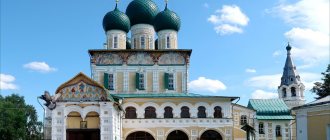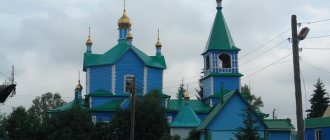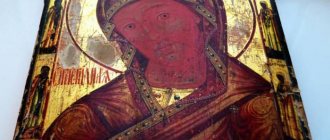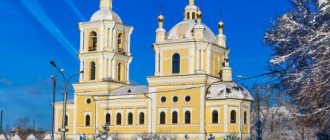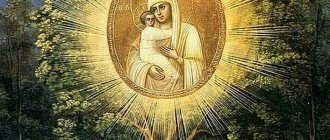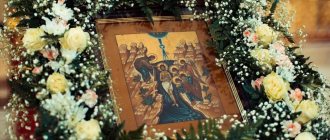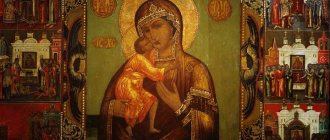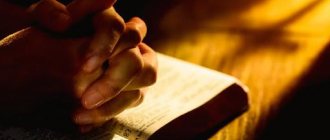Description of the icon “All-Merciful Savior”
This holy image belongs to the iconographic type called the Almighty Savior or Pantocrator. On the icon, icon painters depict the Most Holy Lord God in full growth, waist-deep or chest-deep. Christ holds the Holy Gospel in one hand, and with the other hand blesses the believers. The Holy Book is depicted either closed or open.
Sometimes, instead of the Gospel, a scroll with God’s commandments is drawn in the Savior’s hand. The Most Holy Christ is depicted in a purple tunic and a blue himation. A halo with an inscribed cross and Greek letters on its three sides is drawn around the head of Jesus.
History of appearance
The iconographic type of a single image of the Savior Almighty itself originated at the dawn of Christianity. This kind of fresco can be seen in ancient Roman catacombs. Starting from the 4th century, Byzantine icon painters began to depict Christ the Savior on temple icons, holding the Gospel in one hand, and blessing people with his other hand. With the baptism of Rus', a holy image of such content appeared in Russian churches.
In the 12th century, thanks to prayers to the icon of the All-Merciful Savior, Russian troops under the leadership of His Serene Highness Prince Andrei Bogolyubsky managed to defeat the Volga Bulgarians. In honor of this event, a church holiday was established on August 1 (14), as a reminder of the mercy given by God. Since then, believers in Rus' began to decorate churches, monasteries and chapels with icons of the All-Merciful Savior. The laity placed the most holy image of Christ the Savior in the center of the home iconostasis.
Icon of the All-Merciful Savior in Tutaev
In many churches of Rus' one could find the most holy image of Christ the Savior, blessing the believers. Christians prayed before the icon of the All-Merciful Savior and received God's mercy in return. The most holy image began to be revered as miraculous.
One of the icons depicting the All-Merciful Savior is located in the Resurrection Cathedral in the city of Tutaev, Yaroslavl region.
The most holy image was created around the 15th century. According to one version, it is believed that the ancient icon sailed to Tutaev along the Volga in a boat.
This shrine also has another name - “Savior Borisoglebsky” or “Romanovsky”. The fact is that Tutaev used to be called Romanovo-Borisoglebsk. The most holy image, located in the Resurrection Cathedral for many centuries, is considered miraculous. Prayers to him heal sore limbs and joints. Believers crawl on their knees to the shrine, pray in front of it and receive God's mercy.
The dimensions of this ancient icon are impressive - about 3 meters in height and width. This is a bust-length image of Christ, enclosed in a carved frame and chasuble (crown). The image of the Savior is made in dark colors. In one hand Jesus holds the open Gospel, and with the other he blesses the believers. In days of severe misfortunes and illnesses, residents of Tutaev come to pray to the shrine and receive God's grace.
Icon of the Savior in Tutaev
The famous icon appeared presumably at the beginning of the 15th century for the church of the Russian princes Boris and Gleb, the sons of the great Kyiv prince Vladimir Svyatoslavich. The icon painter Dionysius Glushitsky worked on the shrine. Initially, the icon was located in the dome of the temple; it could only be seen by turning one’s gaze to the “sky.” The dimensions of the icon are impressive: 2.78 m wide and 3.20 m high. Therefore, she was a worthy decoration of the dome. The exact weight of the icon is unknown, but at least 30 men are needed to carry it, and at the same time, everyone will feel the weight of the icon. Every year a religious procession is carried out with the icon; for this, a special metal frame is used to make it convenient to carry the shrine.
The icon was not in the chapel of Saints Boris and Gleb for long. Only in the 18th century did the image appear in the main hall of the church. But he was not at peace for long. In 1749, the shrine was moved to the bishop's house by the will of Metropolitan Arseny. In 1798, the image was carried on foot, carried in arms, to the Resurrection Cathedral, where it is kept to this day. This is how the icon ended up in Tutaev, which until 1918 was called Romanov-Borisoglebsk. Nowadays, along the route of the image, on one of the banks of the Kovat River, where it was washed from dust and dirt that had settled along the way, a holy spring flows out, which has healing properties. Every year on the tenth Sunday of Easter people go out to the religious procession. This event is a real holiday: the icon of the All-Merciful Savior is solemnly taken out from the Resurrection Cathedral, and the procession accompanies it along the way through the entire city. This tradition has existed for many years, even centuries; it seems that time has no power over the shrines and faith of people.
The Icon of the Savior in Tutaev began to darken over time, this is due to the fact that earlier the icons were completed with a layer of sunflower oil to fix the colors. This icon is the only one in the Resurrection Cathedral from which the oil layer was not removed. But the face of the Lord is clearly readable from the icon and, it seems, looks into the soul, exposing it and freeing it. The metal frame that is used in the procession has a special device so that men can lean it on their shoulders and thus carry the icon. The frame has arches so that believers can pass under the face of God while walking or stopping. As in the old days, the icon is carried uncovered, even in rain and bad weather.
Above the Savior’s head is a golden crown, which can rightfully be called a work of art. The crown is decorated with chased patterns. Centuries later, the master’s work has not faded and is still pleasing to the eye.
Veneration in Orthodoxy
The image of the All-Merciful Savior, or the Almighty, can be found not only on the icon, but also under the dome of the temple, in wall paintings, above the entrance to the church. The Most Holy Lord protects the holy monastery, blesses the believers and gives them his teaching as the only way to the salvation of the soul. The icon of the All-Merciful Savior is installed in iconostasis, in stands or hung on the wall of the temple.
They pray to the shrine with the image of the Lord God blessing him, and organize religious processions with it on major church holidays. This is one of the most majestic icons of Orthodoxy. There is also a separate holiday in honor of the All-Merciful Savior. It is celebrated annually on August 1 (14). This holiday is more than 800 years old. It was installed immediately after the victory of the Russian army led by Andrei Bogolyubsky in the battle with the Volga Bulgarians.
On the Assumption Fast, believers celebrate the Honey Savior (August 14). On this day, a festive service is held in churches in honor of the icon of Christ the All-Merciful Savior. Then they celebrate Yablochny and Third Spas.
The amazing journey of the biggest icon in Russia
Twice a year, the icon of the Savior Pantocrator leaves the Resurrection Cathedral in the city of Tutaev, Yaroslavl region, going on an unusual religious procession.
National Geographic Russia No. 211, July-August 2021
read this issue
First, the sound of bells echoes along a quiet street with colorful wooden houses. From somewhere far away, majestic. The sound intensifies, commanding the town to shake off its provincial slumber. The space is filled with singing and discordant human hubbub. Finally, through the vibrating heated air, the reason for the awakening becomes visible: a motley procession, the end and edge of which is not visible.
Clergymen flash in it, festively dressed in gold, women in headscarves, children on the scruff of their parents’ necks. Red-faced men, wet with sweat, walk ahead, slightly bent under an unusual burden. Their burden—the huge three-meter-tall face of the Savior Almighty, decorated with flowers—seems to float of its own accord over this entire sea of people.
On the day of the procession in Tutaev, God certainly, according to Brodsky, “does not live in corners, as scoffers think, but everywhere.” The procession resembles a tsunami, but this is a tsunami of grace, to which people are happy to open the gates: in many courtyards, residents organize free distribution of drinking water, kvass, pies for the participants - to whom God has sent what. There is not that much asphalt in the city, and the path often lies along compacted potholes of the primer. Thousands of feet raise columns of dust. When the religious procession falls on a rainy day, dirty streams flow underfoot, and the Savior is covered with plastic. TWO BANKS OF ONE RIVER
Tutaev is a town in the Yaroslavl region on two banks of the Volga without a bridge between them. Once its parts were different cities - Romanov on the left bank and Borisoglebsky on the right. The first chronicle mention of them dates back to the 13th century. The advantageous trading position on the main waterway led to the growth and prosperity of both cities. The decline of economic prosperity began here with the development of railway communication: the rails were laid too far from the local shores.
This is what the routes of two annual religious processions look like - along the Borisoglebskaya and Romanovskaya sides of Tutaev. The Resurrection Cathedral is marked with a larger icon on the diagram. Photo: National Geographic Russia
In memory of the glorious past, today stone and wooden merchant mansions live here, and the brick vaulted barns of the Stroganovs are overgrown with grass. (They were bought in disrepair by a simple local historian, Yuri Starodubov, and is now collecting funds for restoration - he dreams of creating a museum.)
The united Romanov-Borisoglebsk was born in 1822. Less than a century later, both parts of the name were considered unsuitable: the first - as if about the dynasty of recently overthrown kings (although in fact the name is much older: it comes from the name of the founder, the 13th century Uglitsky prince Roman Vladimirovich), the second - about the first Russian saints Boris and Gleb . This, of course, was not suitable, and in 1918 it was decided to rename the city. We considered options: Leninsk, Lunacharsk, even some incredible Kommunar-Spartak. But they settled on Tutaev - in honor of the dashing Red Army soldier who died in a recent skirmish with white rebels.
There is talk in the city that the skirmish was not a noble battle at all, but a treacherous attack. “And the surname is some kind of Tatar,” local local historians complain in a politically incorrect manner. “We would like to return the former Russian Romanov-Borisoglebsk.” However, supporters of returning the historical name are in the minority: in the post-Soviet years, polls on renaming were conducted more than once, the majority voted against. But the controversy did not subside.
In 2022, the issue was transferred to the State Duma: deputies passed the bill on renaming Tutaev in the first reading, but local authorities decided to hold a referendum again, this time promising: the results will be final, the topic will be closed once and for all. The majority again voted against the renaming, and the topic was closed.
No matter how much you vote, there still isn’t a bridge across the Volga. Communication between the Borisoglebskaya and Romanovskaya sides of Tutaev, like many centuries ago, is carried out by boats and ferry in the summer (tariff - 35 rubles one way), in the frosty winter - on foot on the ice, free of charge. During freeze-up and ice drift there is no communication at all. The nearest bridge is in the administrative center of the region, Yaroslavl, which is half an hour away by car.
The absence of a bridge and a railway connection creates a lot of everyday inconveniences, but, to the delight of painters, it makes time flow more slowly in Tutaev: in its viscous flow, reality seems to be mothballed. You can compare the modern landscape with Kustodiev’s “Walk on the Volga” of 1909 - and find almost no differences.
Bottleneck: the icon of the All-Merciful Savior is transferred from the winter to the summer church of the Resurrection Cathedral.
FORMER "SKY"
The icon of the Almighty Savior is the main city shrine; the Tutaevites call him the All-Merciful Savior. He “lives,” as the locals say, in the Resurrection Cathedral on the Borisoglebskaya side of the Volga. This bank is high, its entire architectural ensemble and the descent to the river are perfectly visible from the opposite side. Dozens of artists and photographers line up along the Romanovsky Bank in advance: the moment of the Savior’s descent to the crossing is considered the most spectacular during the procession.
According to legend, the image of the Savior was painted by the famous Vologda icon painter, Venerable Dionysius Glushitsky, in the 15th century. Before the construction of the stone Resurrection Cathedral in the 17th century, the wooden Boris and Gleb Church stood nearby. The Savior was in it - an element of the ceiling in the quadrangle of the building, and this explains its size: almost three meters in height. When the church was dismantled due to its dilapidation, the Savior was transferred to the new church as an icon. This dating version is recognized by the church and is the most popular among local historians, although some experts believe that the icon is contemporary with the stone cathedral.
“In the middle of the 18th century, by decree of Saint Arseny (Matseevich), the Savior was taken to Rostov the Great for 40 years,” says art historian, keeper of the artistic and historical values of the Resurrection Cathedral, Svetlana Semenova. – The fact is that in Borisoglebsk there lived many Old Believers who revered this icon, and the church fought with them. In 1793, the shrine was returned, having been carried by hand the entire way - about a hundred kilometers. It was then that the first religious procession with the Almighty Savior took place in Borisoglebsk. In 1888, in honor of the 900th anniversary of the Baptism of Rus', the Savior of Boris and Gleb walked along the Romanovskaya side for the first time. There, in Romanov, in the Church of the Archangel of the Savior, which is still active today, there once was a revered image of the Savior, also very large, but time has saved only ours - Borisoglebsky.
The Soviet government stopped the tradition, but since 1989, under the rector of the Resurrection Church, Archpriest Nikolai Likhomanov, religious processions were revived - on the initiative of the local priesthood and parishioners.
Borisoglebskaya side of the city. The climax of the procession: the icon of the All-Merciful Savior was brought to the crossing of the Volga.
Today there are two religious processions with the Savior in Tutaev: the first falls on the tenth Sunday after Easter and takes place only on the Borisoglebskaya side, and the second - the most numerous and spectacular, with a crossing to the Romanovsky bank - according to a long-standing tradition, takes place on the last Sunday before the feast of Elijah the Prophet. In 2022, walking falls on August 1st.
During religious processions, the icon visits churches on both banks, as if welcoming and blessing them. In addition to churches, stops are made in other significant places. On the Borisoglebskaya side this is, for example, the city House of Mercy, a hospital, a nursing home and an Orthodox gymnasium, and on the Romanovskaya side a prayer service is performed near the wall of the prison castle. A communal meal is being held near the Church of the Archangel of the Savior from the mid-18th century.
Tutaevsky's All-Merciful Savior is considered the largest icon in Russia. The movement of the huge shrine through the picturesque landscapes of the town makes a strong impression. Thanks to this, each religious procession is numerous and interesting not only to churchgoers: many come to show themselves, to see others, and to exchange news. The percentage of believers in Tutaev is no greater than in other Russian cities. So, rather than the religious atmosphere, the festival atmosphere prevails here.
CHRIST STEPS TO THE VOLGA
The action begins at six in the morning with a service in the Resurrection Cathedral. Around eight, the icon is taken outside and placed on a specially made stretcher: now everyone can walk under it on their knees in prayer. Photographs of this moment sometimes become a reason for ridicule on the Internet: they say, look, people are crawling on the ground under the icon... Meanwhile, the ritual is widespread not only in Tutaev: believers believe that by passing under the miraculous icon, a person gains higher intercession, which will allow him to get rid of old diseases and troubles or protect yourself from new ones. Unchurched participants in the procession watch the ritual from the side, but, it seems, without a shadow of arrogance and very friendly.
“My family is not religious, but we have been participating in these religious processions from the very beginning, since 1990, because of their unifying power and beauty,” says artist Sergei Takhtamyshev. He was born and lives in St. Petersburg, but Sergei’s ancestors lived in Tutaev a hundred and two hundred years ago. “The atmosphere here is always light: the participants chat and laugh, the priests sprinkle them generously with holy water, they can sprinkle a weak grandmother sitting at the old window, and look into the car and sprinkle the driver. So that everyone gets grace...
Big religious procession along the Romanovskaya side. Sprinkling with holy water during a prayer service at the Church of Tikhon of Amathunt.During the procession along the Romanovskaya side, Sergei tries to get to the other side in advance, so that from there he can admire the fascinating spectacle of the Savior being carried along the slope from the Resurrection Cathedral to the river.
“In the cathedral it looks completely different: there is not enough space to understand the greatness of the image; it was created to be admired from afar,” continues the artist. – A special spectacle opens from the bell tower of the Cathedral of the Exaltation of the Cross: as if a huge Christ himself is walking along Tutaev to the Volga. But it’s also cool to be on a ferry with an icon: people crowd around the immense face, sing prayers, and rejoice.
Upon arrival on the Romanovskaya side, the Savior spends the whole day “walking around” existing churches and places where churches once stood, however, everything is only from the outside - the icon does not fit into any portal due to its dimensions.
The procession makes a stop at each temple so that pilgrims have time to pray. Regular participants in religious processions are well aware of other, unofficial “checkpoints.” For example, local historian Yuri Starodubov traditionally greets everyone in his yard with watermelon, kvass and a sincere conversation.
SERIOUS POWER
The ancient icon is not only very large, it is also very heavy: to carry it in a religious procession requires serious male strength. Photographer Tatyana Nikitina, whose photographs you see on these pages, emphasizes: it is men who become the main characters of the procession - after the Savior himself, of course.
Musician Mikhail Kolomytsev has been wearing the Savior since he moved to Tutaev from Moscow in 2008. For him, the procession is not a simple walk.
- How does it work out? With your body you are present at the procession, but with your soul you are not: you need to look at each other, say hello, and communicate with everyone. And when you take up the stretcher, the chatter ends, you are focused on your actions, plans, dreams.
Mikhail is tall, curly and cheerful. During working hours, he solos on the accordion at the Mosconcert; the rest of the time, he lives near Tutaev, raises children and sheep (sheep of the local Romanov breed), sings mischievous songs of his own composition, heats the bathhouse, rides around his lands on horseback, brews beer and sheep cheese.
“The icon together with the stretcher weighs about 500 kilograms, which for 30-40 men is nonsense at first glance,” says Kolomytsev. “But, harnessing yourself to the Savior, you understand how hard it is, how you are literally pressed into the ground. Maybe it weighs more - who measured it!
The road from the pier to the Resurrection Cathedral. Both banks of Tutaev have steep terrain. On a hot summer day, climbing such a slope even lightly is not easy.
The process has a permanent curator - Vladimir Gridnev. He is a worldly man, but lives near the cathedral. Gridnev is responsible for the composition of the participants; he always walks ahead of the icon, making sure it doesn’t touch branches, road signs, or wires. Gives commands: “On the shoulder!”, “Off the shoulder!”. Listens: if the men grumble from the monotony of the slow pace, he commands them to speed up. He also has a “bench”: when Gridnev sees that someone is very tired, he gives the command to be replaced.
All participants are looking forward to approaching the Church of the Archangel of the Savior, where the refectory tables await them. The table for bearers of the Savior stands separately and is laid out more richly than the general one. Local businesses and residents donate food in advance: some vegetables grown in the garden, some pickles made last year, the bakery of a local engine plant provides pies. Those who do not have their own farm, but want to join, bring a monetary donation.
TO THE RINGING OF BELLS
In the 30 years since the revival of the tradition, much has changed in it. One of the latest innovations is that the religious procession is now accompanied by a car with a bell installation. Moreover, the scale of the event requires artificial amplification of sound. Previously, the function of bells in the procession was performed by beats - simple ancient instruments made of metal plates that made a ringing sound when struck. Today, bells are provided by the local bell factories of the Shuvalov brothers, located on both banks. On the right, Borisoglebsky, bank, the procession is accompanied by bells from Vladimir Aleksandrovich Shuvalov, on the left, Romanovsky, by bells from Nikolai Alexandrovich.
Since 2015, on the eve of the procession, the city has hosted the “Before the Savior” bell ringing festival. Officially, it lasts one day, but in fact, during the procession it continues in its mobile version: the procession moves to the sound of bells from festival participants. The rector of the Resurrection Cathedral, Father Vasily Mozyakov, is confident that thanks to holding two events on one weekend, the Tutaevsky Bell Festival can be considered the largest in Russia in terms of the number of spectators.
Another change: in the 1990s, women carried the crown removed from the icon from the cathedral in advance so that it would not be damaged when carried through the portal. And today women are excluded from the process: they only accompany the event as part of the choir...
- They probably told you that Father Vasily forbade it? – comments the abbot. – Yes, we stopped using women in carrying the crown. But this is correct: it is prescribed that sacred objects be carried into the religious procession by the ministers of the temple, and if there are not enough of them, by pious men from among the parishioners. Women had to be involved when the religious procession was smaller, but today there are quite enough men.
A prayer service at the 17th-century Holy Cross Cathedral on the Romanovskaya Side is a popular subject for photographers and artists. The temple stands on the site of an ancient settlement in the oldest part of Tutaev.
Over the past years, the route has also changed slightly: in addition to the churches on the Romanov side, the procession enters the Leontief Cemetery to the grave of Archimandrite Pavel (Gruzdev), a controversial but revered elder who lived in the gatehouse at the Resurrection Cathedral for three years until his death in 1996. It is believed that it was Father Paul who came up with the idea of reviving religious processions. The former prison, where Romanovo-Borisoglebsky presbyter Pyotr Zefirov was shot in 1918, has also recently been included in the route.
A couple of years ago, a new metal stretcher for the icon was produced by the Rybinsk Shipyard to replace the worn-out wooden ones. These huge stretchers stand all year round to the left of the entrance to the cathedral, recalling the scale of the main Tutaev event.
In recent pre-Covid years, the number of the procession was three to four thousand people. In 2020, due to the pandemic, the tradition was not interrupted, but the number of participants in the procession was significantly reduced.
DIALOGUE WITH GOD
“You can touch the Savior in the cathedral - at any time,” says Mikhail Kolomytsev. – To offer a prayer, to ask for something... But to spend the whole day side by side with an icon is completely different! A meditative dialogue takes place here, without haste and usual ceremonies. You find yourself alone with God, but in the company of close people and old friends, in extreme physical stress, but in a stream of soft grace. You approach the stretcher with new strength, you think: I’m a hero, now I’ll help the peasants! You harness yourself to the Savior, but nothing changes: you float as before. Or, at the end, you will weaken, unclench your fingers for a moment - and Spas will still continue to float above the crowd. But you can’t let go: no matter how you look at it, it’s not he himself who floats.
July 26, 2020. The rector of the Resurrection Cathedral, Archpriest Father Vasily Mozyakov, in prayer at the icon after the end of the Great Procession.
Immediately after the religious procession, pilgrims, artists, photographers and tourists leave in different directions: you have to hurry, in Tutaev there is only one tiny hotel and a couple of guest houses that cannot accommodate everyone. With the onset of dusk, the city plunges into the usual provincial slumber. But everyone knows: another bright awakening will come in due time.
What do they ask for before the image?
Christians have been praying before the image of the Most Holy Lord, blessing people and holding the Gospel in his hand, for several centuries in a row. The All-Merciful Savior is one of the main temple icons. In front of the shrine, prayers are read, church hymns are sung, and services are held. Christians glorify the Lord, thank him for life, ask for mercy, intercession and salvation.
People with diseases of the legs, arms and joints pray to the Most Holy Image of the All-Merciful God. It is believed that prayers to this icon help believers to recover. In many churches there is a holy image of the All-Merciful Savior, around which people have prayed for centuries and received healing from God for their ailments.
Orthodox Christians in Russia consider the shrine to be their divine shield from enemies. During times of enemy attack, believers prayed before the most holy image of the Lord and received heavenly protection. The icon of the All-Merciful Savior was carried in their arms into battle with the enemy, and each time they won the battle.
The shrine helps to defeat not only the visible, but also the invisible enemy. Prayers to the most holy image protect believers from the devil’s machinations, save them from slander and unfair accusations. Innocently convicted, unjustly offended and slandered people pray to the Most Holy Lord. The shrine also helps with mental disorders.
They pray to the Most Holy Savior, who blesses Christians, at times of sorrow or temptation. The Lord helps people find peace of mind and come to terms with God’s will, which sometimes seems too cruel. In fact, God specifically sends trials to Christians so that believers, through suffering, can cleanse their souls from sin.
Prayers to the most holy icon of the All-Merciful Savior help strengthen faith in Christ and live life in accordance with the commandments of God. By praying to the shrine, people ask the Savior to guide them on the righteous path, to protect them from the fall, to give them strength to endure all trials. They pray to the Most Holy God for forgiveness for sins. Believers trust in the mercy of the Lord and hope that after death Christ will accept their soul into his Heavenly Kingdom.
Icons of the Resurrection Cathedral in Tutaev
The most revered icon of the cathedral is “The All-Merciful Savior” (“Oplechny”). According to legend, the icon was created by the Monk Dionysius of Glushitsky at the beginning of the 15th century. This huge, almost 3-meter iconographic image has long been considered miraculous. People come here to get rid of serious illnesses, especially those related to the musculoskeletal system. There is a certain ritual for this: in the lower left corner of the icon there is a hole through which the person asking must crawl through three times, reading certain prayers. At least twice a year on great holidays, the icon is carried in processions of the cross, which requires at least 20 very strong men.
Among the iconic icons of the cathedral, one can also note the Icon of the Mother of God “Hodegetria” in the “winter” church and the carved image of St. Nicholas the Wonderworker.
© Official website of the Resurrection Cathedral
Prayer text
In front of the most holy image of Christ, it is customary to pray for forgiveness of sins, salvation of soul and body, and protection from enemies. The Holy Lord is begged to help overcome everyday difficulties, protect relatives from danger, and grant health and a comfortable life.
People suffering from physical and mental illnesses pray before the icon of the All-Merciful Savior. Prayers to the most holy Lord work miracles. People recover and thank Christ for their healing and miraculous salvation.
In the prayer text read in front of the most holy icon, believers glorify Jesus and ask him for mercy and grace. Holy prayer to the Lord helps people find peace of mind and consolation in sorrows. Believers, having sincerely repented of their sins, receive the protection and intercession of Christ the Savior.
Prayer to the icon of the All-Merciful Savior
Good Lover of Mankind, Most Merciful Lord, who bore our illnesses and healed us with Your wounds. Before Your Majesty, we bow and humbly pray to You: look, O Compassionate One, upon Your servants; and just as in ancient times You healed the weakened, so now, O Good Healer, with Your mercy and generosity, visit Your servants, and heal our sinful illness. Transform our mental and physical ailments into health, transform our infirmities into strength, transform our sorrows into joy and transform our sorrow into consolation. Take away from us all despondency and oblivion, strengthen our minds and confirm them to always learn from Your commandments; Correct all our lives so that we may do Your good and perfect will, for You are the healer of our souls and bodies and we send glory to You forever and ever. Amen.
